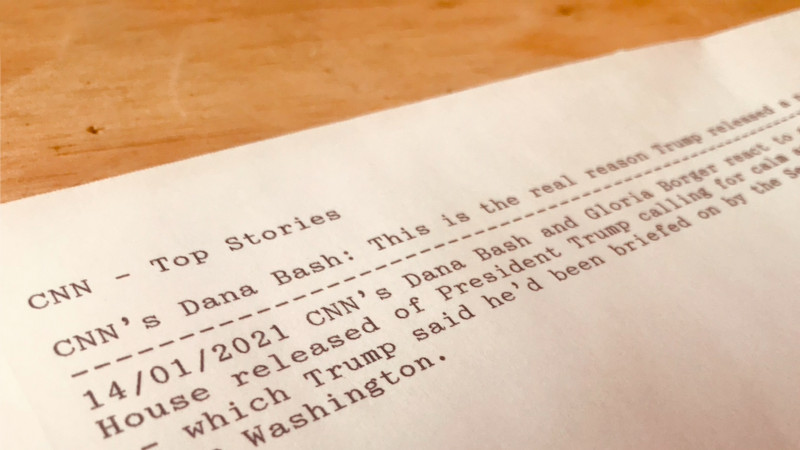These days, we’re alerted to the rise of Bitcoin and the fall of nations via little buzzes from the smartphones in our pocket. Go back fifty years or so and it was all a bit more romantic, with noisy teletype machines delivering hot tips straight to the newsroom for broadcast to the wider public. [Joshua Coleman] wanted a bit of that old fashioned charm, so set up a news printer at home with his old Apple II.
The Apple II in this case isn’t directly connected to the Internet. Instead, it talks to a modern Macintosh, acting as a serial terminal. The Macintosh then connects to a modern BBS that delivers news headlines over Telnet. The Apple II then routes the headlines as they come in to a beautiful Epson LQ-500 dot matrix printer, replete with vintage tractor feed paper. [Joshua] takes the time to highlight just what hardware is required, as well as how to set up the Apple II to redirect the serial output to the printer so the news automatically prints as it comes in.
It’s a fun and noisy way to stay up to date, and you can be sure that if you hear the printer really start going for it, you might want to switch on the TV for more information on just what’s going wrong at the present minute. Old computers may not have the grunt to really hang with the modern net, but they can make a charming interface for it; this SE/30 does a great job with Spotify, as an example. Video after the break.















Ah, the sounds of impact printers. It’s been a while. I wonder if there’s a website where you can enter a decade and hear the sounds of computers of that time.
Why?
I don’t hear those frequencies anymore !!!
Where did he get a fresh “ink” cartridge for the printer?
Still easily available on eBay
Hey! Joshua here. I found it on Amazon for 6 bucks! Fresh stock and plenty of it.
The word you’re looking for is ‘ribbon’. :)
I still see Okidata Microline printers at appliance parts distributors and hotel check-in desks occasionally even now. Those printers would have been buzzing away for close to 40 years. They use Underwood typewriter style ribbons on two spools, which is about as simple as it gets for the ink consumables – a standard that has been around since at least the 1930s.
I recall writing a graphic driver in IBM PC Borland Turbo C driver for the ImageWriter back in the 1990s to print out waveforms from a biology experiment. It was a fairly easy printer to work with and handy to connect because it used a serial port. The ImageWriter was pretty rugged and nicely made. I never looked into who made the mechanism for Apple, but off the cuff it resembles C. Itoh printers of the day. Unlike today, the hard copy manual included in the box with the ImageWriter documented the escape codes and explained how to format sending a band of raster image to the printer. Later, I had to write an HP Laserjet driver. The Laserjet didn’t come with the HP-PCL documentation, but it was available for free on request – about five pounds of books.
Started reading the linked story about the Mac SE and read, “ The Macintosh SE/30 is the greatest computer ever made…”. Having not looked at the author, I thought, “bet Benchoff wrote this one”. Looked at the authorship and …. BINGO! 🤣
He did have that unrestrained knack of writing trigger headlines.
The neat thing about those dot-matrix printers is you could tell the content of what was printing from the sound.
Maybe someone will write a program to restore the exact text from an audio file.
Brings back memories!
When I worked for a public radio station back in the 90s we had a couple of PCs (I mean PCs as in the original IBM PC) connected to dot matrix printers in the news room that printed the AP news feed 24×7. They received it from a serial or parallel (I don’t remember which) link to an OS2 box in another room that was connected to a satellite on the roof.
I remember the ascii graphics that were used to print in ASCII the images
of Captain Kirk, Mr. Spock, Dr. Mccoy, and Scotty.
I think I still have a printout somewhere in my storage unit of those.
Close up they look like ASCII but as you moved further away, it looked
like a picture. There was something back in the 80’s called “Computer-Eyes”
that I saw advertised that would produce these printouts.
With a squirt of WD-40 I made it into one of the rustier parts of my memory, and it seemed to think that this…
http://netghost.narod.ru/gff/graphics/software/msdos/gwsdos.htm
was one of the DOS programs you could do it with (There was a Win3x version too I think)
They should go the whole 9 yards, and drop an ethernet card in the Apple II, and have it telnet directly.
I may just yet. You talking about the Uthernet Card? I see a new production line is available but they are not compatible with the II+ which is the model I used in this project.
Well, I still have and use 5 Apple ][‘s in one form or the other. They just released an epic new RPG (Nox Archaist) for the Apple ][. My Epson LQ1000 is still in service as well. Apple II forever!
50 years? We had an AP feed in use 30 years ago when I was working at my college radio station.